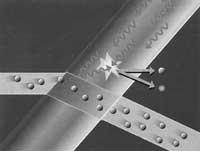Light becomes matter
Quantum
electrodynamic theory developed in the 1930s argues that two particles of light or high-energy photons are sufficient to form the pair of electrons/positroi (i.e. matter). However, so far it has not been possible to raise the energy of the photon to sufficient level in the laboratory.

Now, at the Stanford Linear Accelerator Center (Slac) in the United States, in an essay, they have collided between two photons. High intensity laser photons are lead to electron beams around the speed of light. Photons are diverted like this and their energy is 1.012 times higher. They get 5 GeV of energy, but this level is not enough to produce matter. Therefore, the team of the Slac center has encouraged these photons to bounce off the flow of the laser and to activate non-diverted ray photons. Enough energy is released in the shock to generate the pair of electrons/positrons.
This essay has confirmed the predictions of quantum electrodynamics and also serves to know what happens when the photon accelerates electromagnetic fields on the surface of neutron stars away from us.
Buletina
Bidali zure helbide elektronikoa eta jaso asteroko buletina zure sarrera-ontzian











